Disclaimer: I am not affiliated with any of the brands or products mentioned in this post, and I do not receive any compensation for the links provided. These links are included solely for your convenience to help you find more information.

Welcome back to the Skill-Wanderer’s Playbook. In our series so far, we’ve explored the sprawling “supermarket” of Udemy and the specialist “tech gym” of Pluralsight. Today, we’re taking a look at a platform that holds a special, nostalgic place in my own career journey: LinkedIn Learning.
🎯 Quick Reference: Want a visual summary of this entire playbook? Check out our interactive infographic for all the key strategies, rules, and insights at a glance.
Editorial Independence: This review is completely independent. I have not received any compensation, sponsorship, or free products from LinkedIn Learning or any platform mentioned. All opinions are my own, based on personal experience with subscriptions I paid for myself. Read more about my editorial integrity principles.
A Personal Detour: My First E-Learning Platform
Before we dive into the formal review, I want to start with a story. Long before I was a developer or a PM, I worked as an import-export manager. My job involved finding and reaching out to potential customers overseas, so naturally, I had to sign up for LinkedIn to build my network.
While exploring the platform, I saw an offer for a one-month free trial of LinkedIn Learning. “Nothing to lose, right?” I thought. Around that same time, our company was in the process of building its first website. Out of pure curiosity, with no real career goal in mind, I started a course on HTML and CSS.
That was it. That was the spark.
For me, LinkedIn Learning wasn’t just another platform; it was the first e-learning platform I ever seriously used. It was my gateway into the world of tech and the first step on a path that would eventually lead to a complete career change. It will always be a very nostalgic platform for me, even though, as we’ll discuss, I don’t use it as much for my core technical skills anymore.
So, is it just a sentimental favorite, or is it a powerful tool for tech professionals today? This deep dive will analyze its unique strengths, its notable weaknesses, and provide a playbook for leveraging it to accelerate your career.
When Should You Consider LinkedIn Learning? A Quick Guide
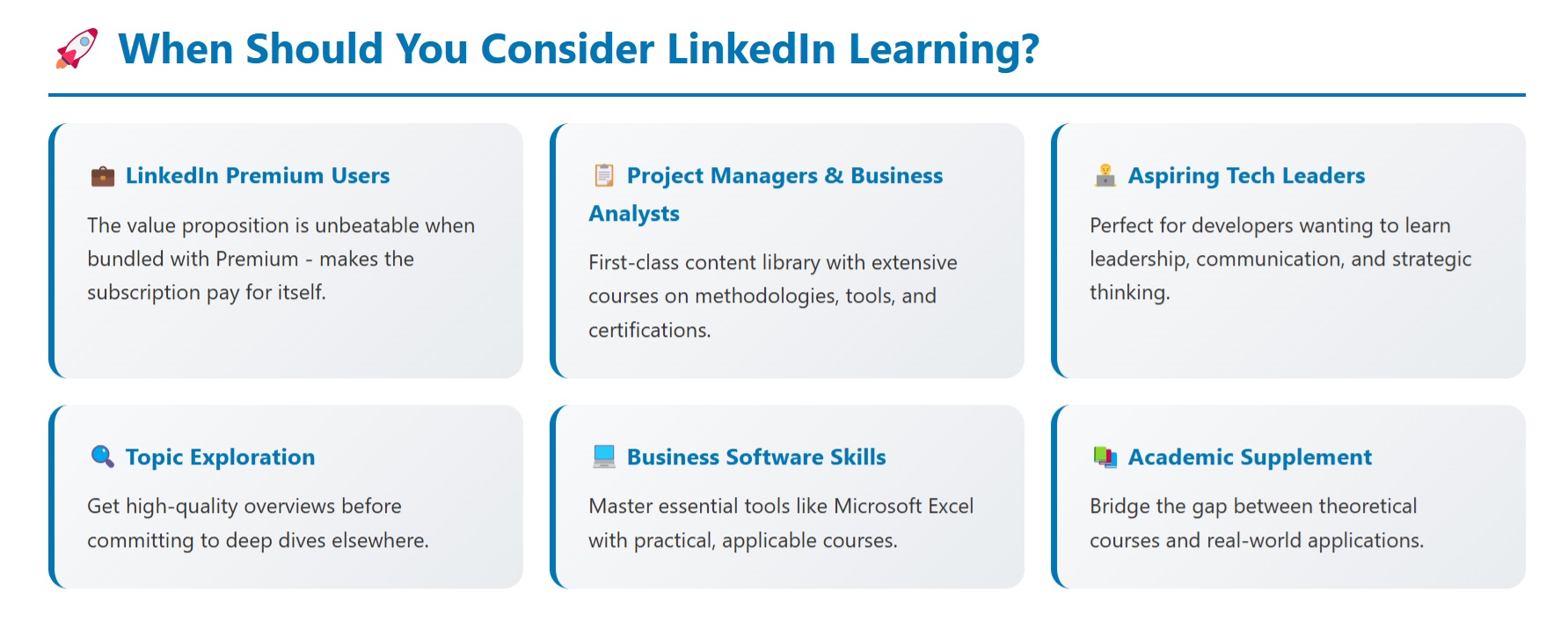
Before we get into the details, let’s establish when this platform makes the most sense:
You already have or are considering LinkedIn Premium. The value proposition is unbeatable when it’s bundled.
You are a Project Manager or Business Analyst. The platform’s content library is a first-class citizen for these roles, with extensive, high-quality courses on methodologies, tools, and certifications.
You are a developer aspiring to become a Tech Lead, Architect, or Manager. This is the best platform for learning the crucial “other half” of the job: leadership, communication, and strategic thinking.
You want a high-quality overview of a topic before committing to a deep dive elsewhere. Its concise, professionally produced courses are perfect for exploring a subject quickly.
You need to upskill in essential business software. For skills like mastering Microsoft Excel, its courses are practical and directly applicable to any role.
You need practical supplementary material for a more theoretical course. I personally used LinkedIn Learning alongside my online university courses to see real-world applications of the concepts I was studying.
Understanding the LinkedIn Learning Model: Integration, Curation, and Professional Polish
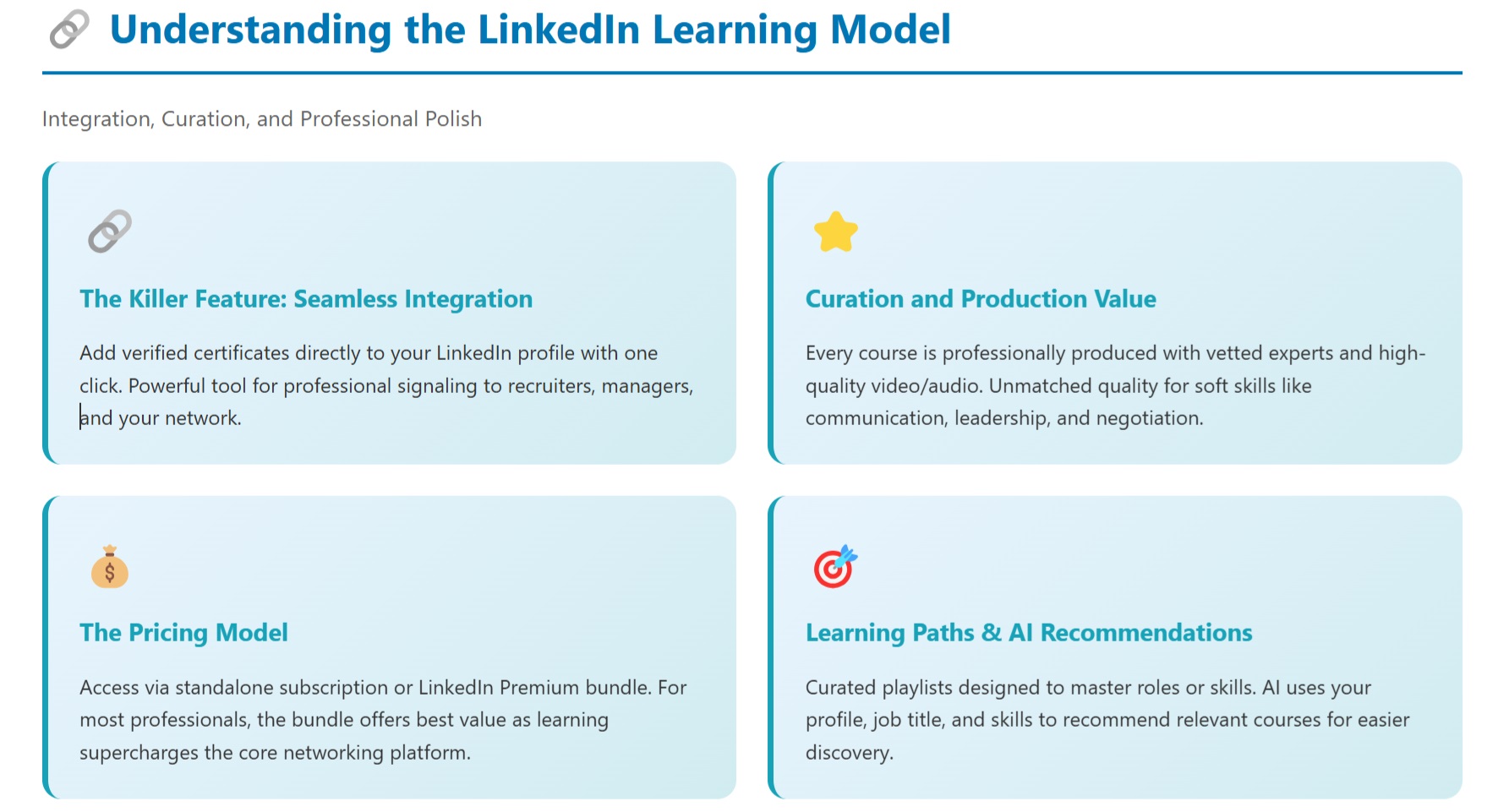
The Killer Feature: Seamless Integration
This is its biggest differentiator. Completing a course allows you to add the verified certificate directly to your LinkedIn profile with a single click. This is a powerful tool for professional signaling—a direct way to show recruiters, managers, and your network that you are actively upskilling.
The Curation and Production Value
Contrast this with Udemy. Every course on LinkedIn Learning is professionally produced with vetted experts and high-quality video/audio. The library is vast, covering almost any topic you can imagine, from deep tech to business strategy and even creative arts, so there is nearly no lack of topics for you to explore. Crucially, when it comes to learning soft skills—like communication, leadership, and negotiation—there is no better place than LinkedIn Learning. Its quality in this area is unmatched.
The Pricing Model
There are two ways to access the platform: a standalone subscription or as part of the LinkedIn Premium bundle. For most active professionals, the bundle offers the best value, as the learning component supercharges the core networking platform.
Core Features:
Learning Paths: These are curated playlists of courses designed to help you master a role or skill (e.g., “Become a Business Analyst”).
AI-Powered Recommendations: The platform uses your LinkedIn profile, job title, and skills to recommend relevant courses, making discovery easier.
The Playbook for Maximizing LinkedIn Learning
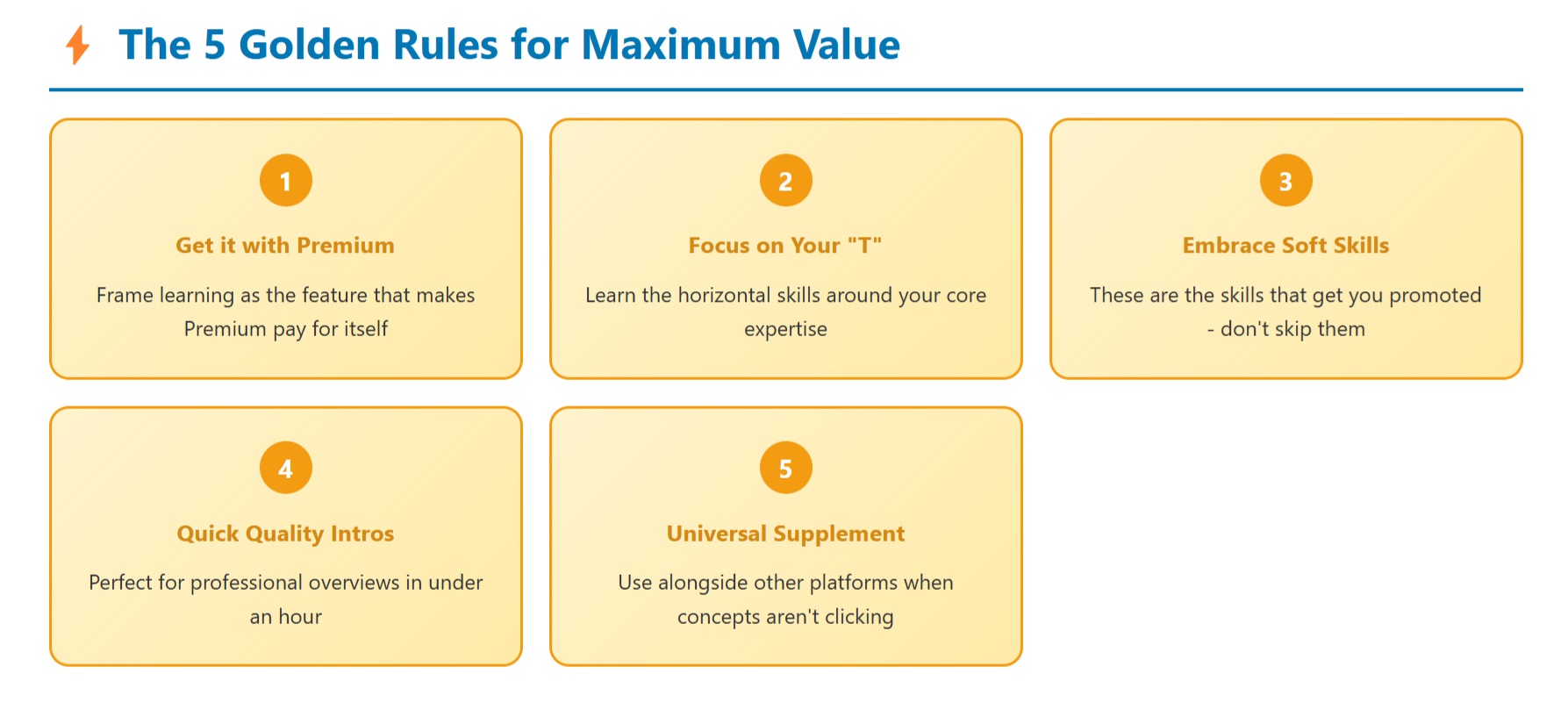
Rule #1: Get it with Premium
Frame the learning platform as the feature that makes Premium pay for itself.
Rule #2: Focus on the “Horizontal Bar” of Your “T”
Use it to learn the skills around your core job (e.g., a coder learning project management).
Rule #3: Don’t Skip the Soft Skills
Emphasize that this is where the platform truly shines and that these are the skills that get you promoted.
Rule #4: Use it for Quick, High-Quality Intros
Perfect for getting a reliable, professional overview of a business concept in under an hour.
Rule #5: Use it as a Universal Supplement
LinkedIn Learning is one of the best supplementary resources in any learning stack. I’ve used it alongside my online university courses to get a different perspective on academic topics. I also use it in conjunction with courses on Udemy, Pluralsight, or Coursera when a concept isn’t clicking.
LinkedIn Learning for the Tech Team: A Role-Based Breakdown
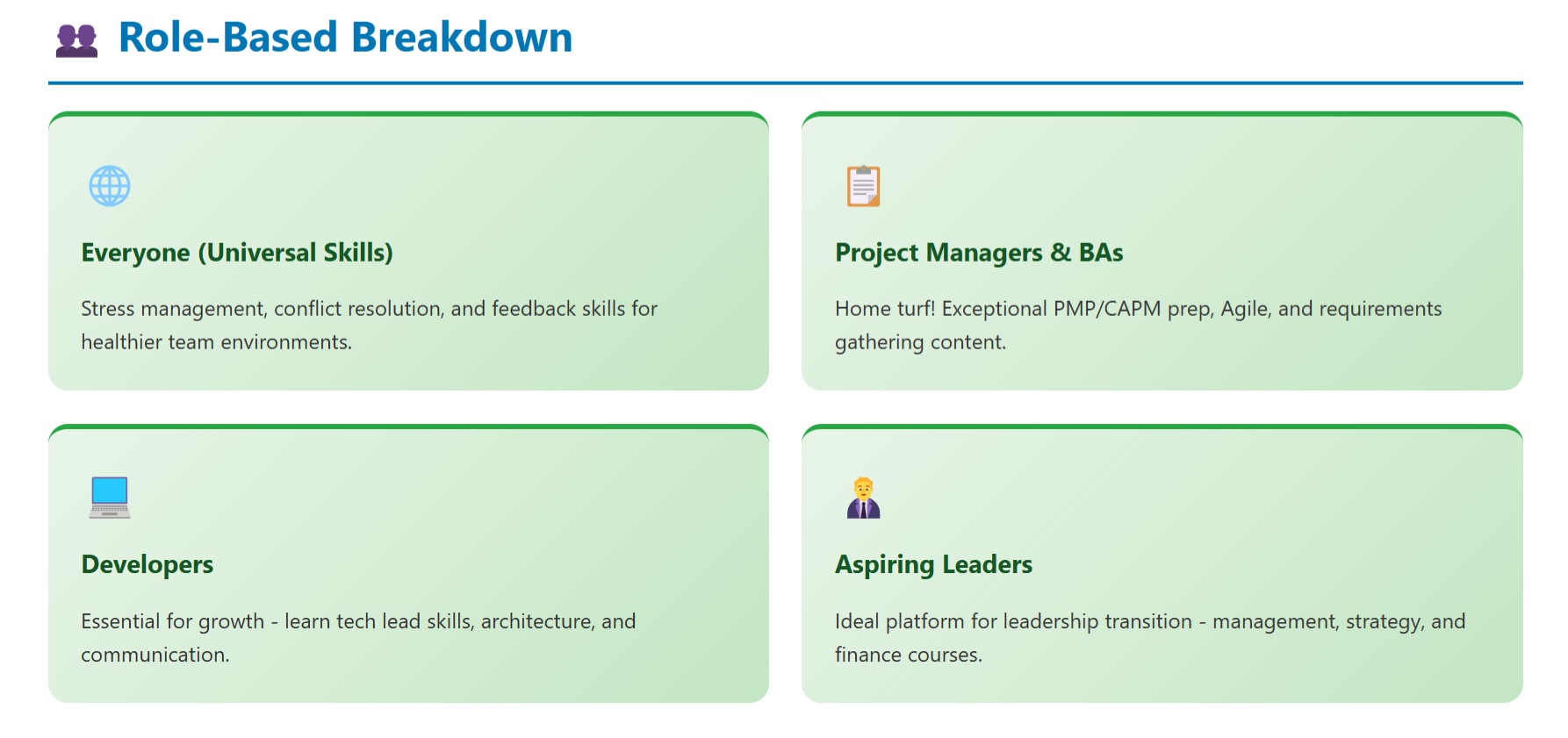
For Everyone (The Universal Skills)
Regardless of your specific title, a little bit of soft skill training is always useful. Courses on topics like stress management, conflict resolution, or giving effective feedback are invaluable for creating a healthier and more productive team environment. LinkedIn Learning excels at providing these universal professional skills.
For Project Managers & Business Analysts
This is their home turf. The library for PMP/CAPM prep, Agile, and requirements gathering is exceptional. I have personally built much of my PM and BA skillset by combining platforms. For project management, I took the formal Google Project Management Certificate on Coursera as my foundation and then used LinkedIn Learning for supplementary courses on specific Agile techniques and stakeholder communication. For business analysis, I combined the technical BA courses on Pluralsight with the invaluable communication and modeling courses on LinkedIn Learning.
For Developers
For deep, cutting-edge technical skills, Pluralsight is superior. However, for a developer who wants to grow, LinkedIn Learning is essential. It’s the best place to learn the skills needed to become a tech lead or architect, like software architecture foundations and communicating technical concepts. On the practical side, I successfully learned Java and the Spring Framework by combining the foundational concepts from a LinkedIn Learning path with a deep, project-based course on Udemy.
For Aspiring Leaders & Managers (All Roles)
This is the ideal platform for making the leap into a leadership position. The catalog of courses on management fundamentals, leading teams, strategic thinking, and finance is second to none.
Stacking LinkedIn Learning: The Professional Polish
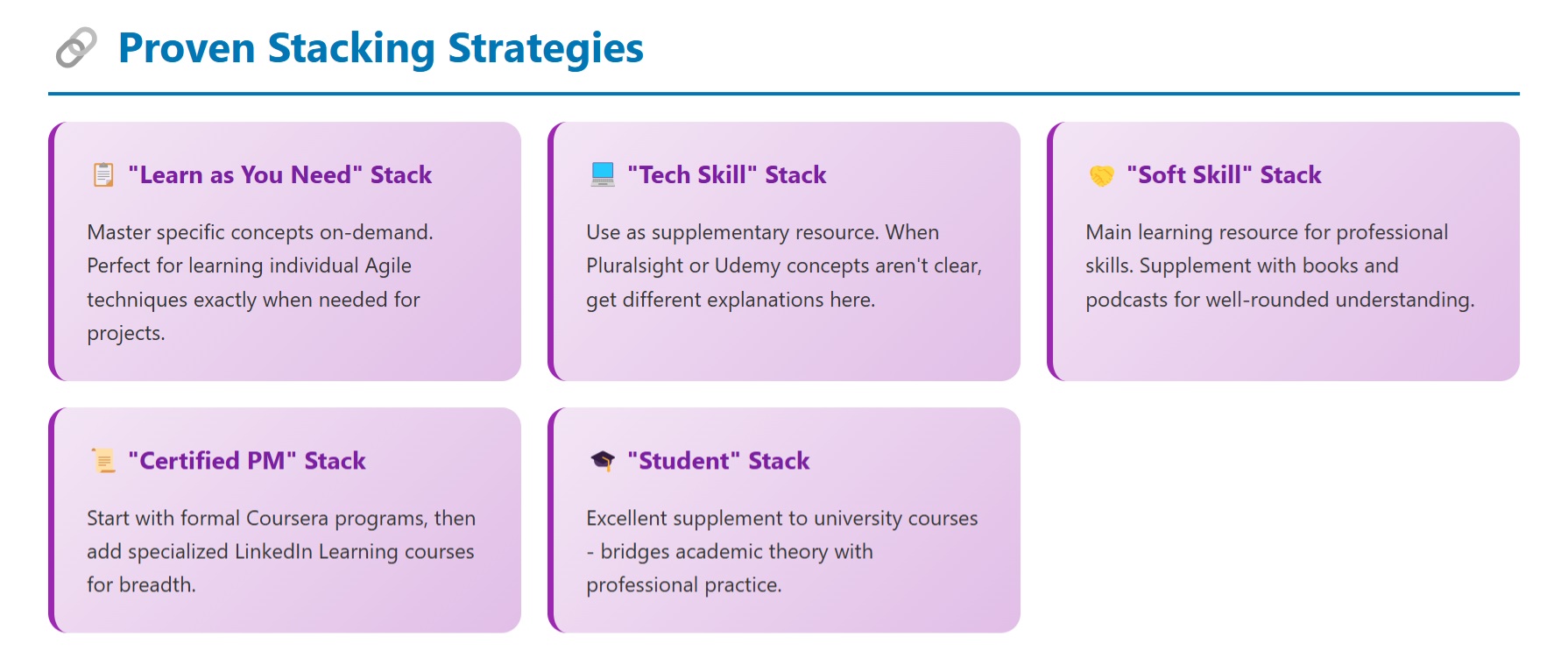
The “Learn as You Need” Stack for Non-Tech
This is a powerful strategy for mastering specific concepts on the fly. I have successfully learned and mastered separate Agile concepts this way. Instead of taking one massive Agile course, I used LinkedIn Learning to find short, high-quality courses on how to hold a retrospective meeting, how to write effective user stories, and other specific skills exactly when I needed them for a project.
The “Tech Skill” Stack
For hard technical skills, I use LinkedIn Learning purely as a supplementary resource. When I’m taking a deep-dive course on Pluralsight or a project-based course on Udemy and a concept isn’t clear, I’ll often search for the same topic on LinkedIn Learning. Hearing a different, highly-polished explanation can often provide the clarity I need to get unstuck.
The “Soft Skill” Stack
When it comes to professional and soft skills, the roles are reversed. Here, LinkedIn Learning is my main learning resource. I will take their comprehensive courses or learning paths on topics like leadership or conflict management as my foundation. I then supplement this core learning with different perspectives from books or podcasts on platforms like Amazon’s Audible to get a well-rounded understanding.
The “Certified PM” Stack
Start with a formal program on Coursera (like the Google PM Certificate), then use LinkedIn Learning to add breadth with specialized courses on different Agile flavors or risk management.
For Students
LinkedIn Learning can be an excellent supplement to university or college courses. The high-quality, practical videos can provide a real-world context that is sometimes missing from academic lectures.
The Final Verdict: Is LinkedIn Learning a Must-Have?
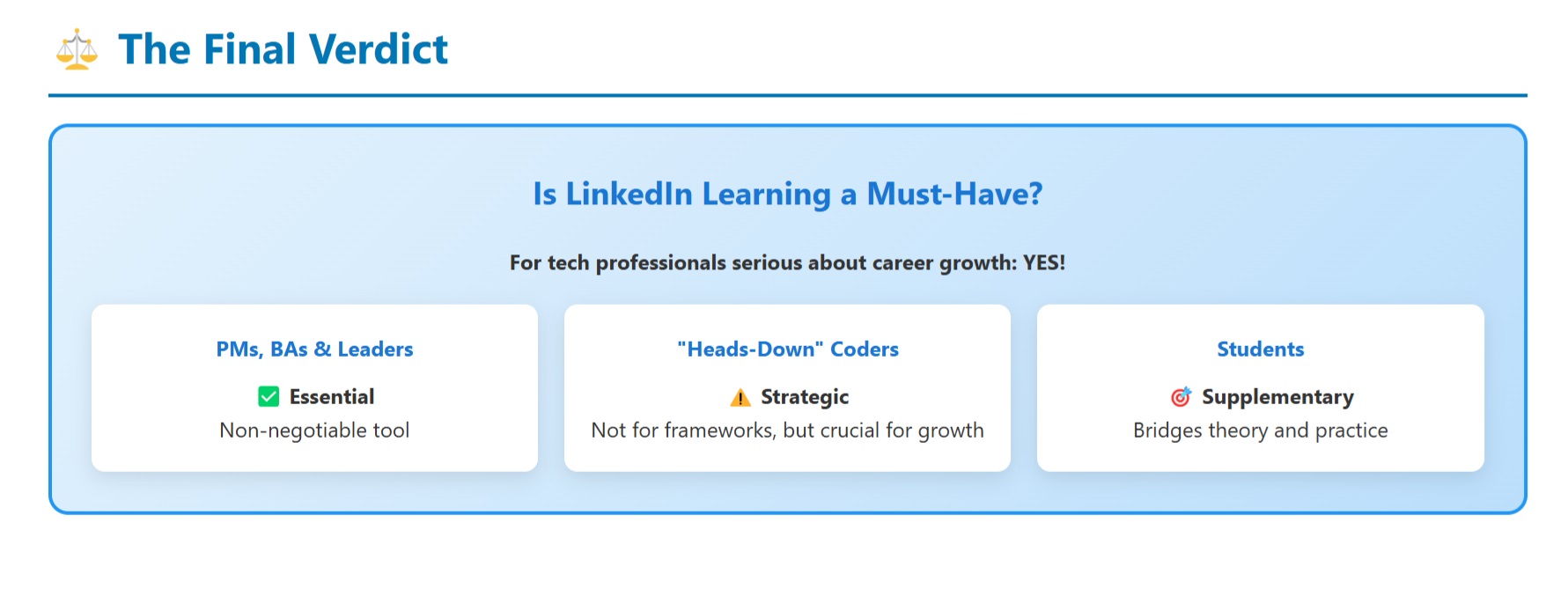
For any tech professional serious about long-term career growth, yes, it is.
For PMs, BAs, and Aspiring Leaders: It is an absolutely essential, non-negotiable tool.
For “Heads-Down” Coders: While it shouldn’t be your primary tool for learning the latest JavaScript framework, ignoring it is a strategic mistake. The skills it teaches are what separate a good coder from a great team member and future leader.
For Students: It’s a powerful supplementary tool that can help bridge the gap between academic theory and professional practice.
Final Analogy: If Udemy is the supermarket and Pluralsight is the specialist gym, LinkedIn Learning is the executive business school where you learn the professional “how” and “why.”
What’s Next in the Playbook?
We’ve covered the platforms for generalists and leaders. Now it’s time to head back to school. In our next deep dive, we’ll explore the “digital university” and review the platform that partners with the world’s top institutions: Coursera.
To get the next deep dive delivered directly to you, be sure to subscribe to the blog.
You Are Here at the Blog - Explore Our Full Ecosystem
Welcome to the Skill-Wanderer blog! This is just one part of our comprehensive ecosystem designed to transform how you learn and grow in technology. Here’s where you can connect with us:
🌐 Our Mission Hub: Skill-Wanderer.com
Discover our complete mission, values, and approach to education. This is your gateway to understanding how we’re building a better future for tech learning.
📝 Our Knowledge Base: wanderings.skill-wanderer.com
You’re currently reading our central hub for insights, tutorials, and behind-the-scenes content. Here we share technical deep-dives, learning strategies, industry perspectives, and “The Wanderer’s Log” series where we build in public and document our journey of creating better educational experiences.
🥋 Our Learning Dojo: dojo.skill-wanderer.com
Your hands-on learning destination where theory meets practice. Our comprehensive learning management system delivers courses, projects, and real-world challenges designed to build genuine expertise. The dojo is technically ready and our first courses are currently under development.
🤝 Coming Soon: Our Community Hub
We’re actively developing a dedicated community microservice that will connect learners, facilitate collaboration, and create spaces for knowledge sharing. This will be the heart of peer-to-peer learning and mentorship within the Skill-Wanderer ecosystem.
About Skill-Wanderer: Where Education Meets Real-World Impact
Skill-Wanderer operates as a non-profit technology education organization with a unique dual approach that sets us apart:
🎓 Educational Mission: We provide high-quality, accessible technology education that removes financial barriers and focuses on practical, real-world skills. Our courses are designed not just to teach concepts, but to prepare you for the challenges you’ll actually face in your tech career.
⚙️ Technology Services: We also operate mission-aligned technology services that serve a dual purpose:
- Funding the Mission: Revenue from our tech services directly funds our educational programs, ensuring sustainability without compromising our values
- Living Laboratory: Our real-world client work becomes the foundation for our educational content, ensuring everything we teach is current, relevant, and battle-tested
🔧 Platform Development as Learning: The experience of building and evolving the Skill-Wanderer platform itself becomes invaluable real-world content for our educational programs. Every technical decision, challenge overcome, and solution implemented in creating our own infrastructure provides authentic case studies and practical insights that we share directly with our learners.
This integrated approach means when you learn with us, you’re not just studying theoretical concepts—you’re learning from actual implementations, real challenges, and proven solutions. Our instructors aren’t just teachers; they’re practitioners actively working in the field, and that experience flows directly into our curriculum.
The Skill-Wanderer Difference: We bridge the gap between education and industry by being actively involved in both. Every course, every project, and every lesson is informed by real-world experience because we live and work in the same technological landscape we’re preparing you to enter.


